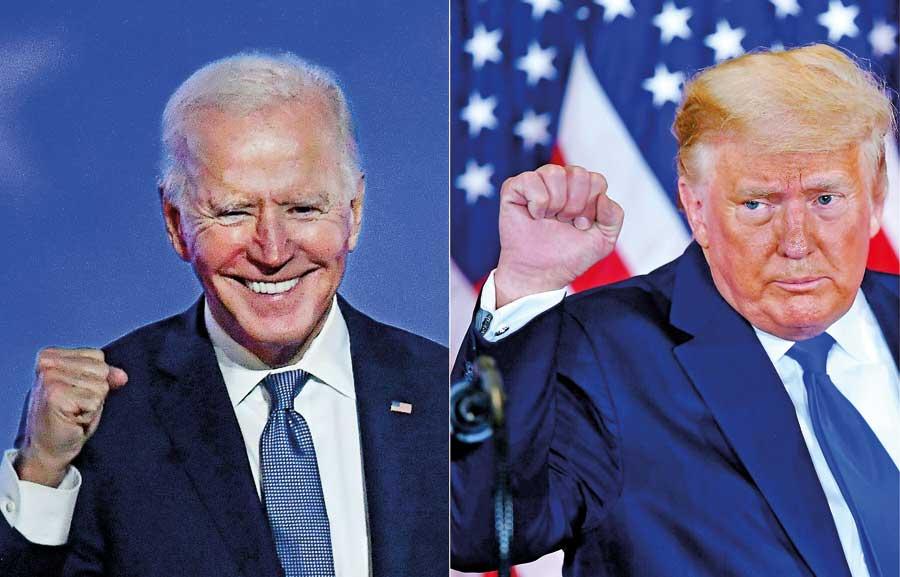Reply To:
Name - Reply Comment

This combination of pictures created on November 4 shows Democratic presidential nominee Joe Biden (L) in Wilmington, Delaware, and US President Donald Trump (R) in Washington, DC both pumping their fist during election night speeches. AFP
What is separating United States President and Republican candidate Donald Trump and the much fought for  second presidential term is a remote possibility of courts upholding the cases his campaign team has filed challenging the legality of the mail in votes in several battleground states.
second presidential term is a remote possibility of courts upholding the cases his campaign team has filed challenging the legality of the mail in votes in several battleground states.
The curtains are probably coming down on an administration widely regarded as the most dangerously unpredictable in the US’ democratic history, what with allegations of Russian hacking that led to his election victory in 2016 and impeachment proceedings in the US Congress to boot.
By the time this article was being written yesterday, Trump’s presidential race rival and Democratic Party candidate Joe Biden was approaching the winning post in a nail-biter that was keeping hundreds of millions of people in America and across the world glued to their seats as the flow of the election results got stuck in a painstaking stagnation pending the results of key battleground states of Arizona, Nevada, Georgia, Pennsylvania and North Carolina.
With Associated Press, the CNN and other media networks calling Wisconsin and Michigan for former Vice President Biden who won a record popular vote in US history, the scorecard read yesterday morning 253-213 in favour of the Democratic Party candidate. But with each passing minute, the fortunes seesawed. Biden was leading in Arizona, but Trump was narrowing the gap. There was uncertainty over Nevada where Biden had a narrow lead. Biden was closing the gap in Georgia to reach the victory target of 270 electoral votes even without Arizona, but probably with Nevada’s six electoral votes. In North Carolina, final results will not be known till November 12 or 13 until all mail-in ballots are received and counted by each county.
Amidst this political haze, some outlets, however, called Arizona for Biden and placed him at 264 electoral votes.
But the situation was turning volatile yesterday with Trump supporters gathering outside counting centres and demanding that the counting should be stopped after Trump prematurely claimed victory and told supporters in a televised speech that the election which he can’t lose was a fraud and he would go to the Supreme Court to stop the count.
With hundreds of thousands of urban centre votes yet to be counted along with mail-in votes which tendeto favour Biden, the Democratic Party candidate appears set to move into the presidential residence at No. 16, Pennsylvania Avenue in Washington DC. As the knife-edge contest continued, the real winner is the US democracy which has put in place safety mechanisms at state and federal levels to ensure that the people’s will is not distorted, although not so long ago allegations of disenfranchising the black community voters on the basis of criminal records had cast some aspersions on the system. It cost the Democratic Party the White House in 2000, the year in which the system was dealt another mighty blow by the US Supreme Court in what is now criticised by academics and legal experts as a warped judgement on the Florida vote count dispute.
As the battle for Florida’s 25 electoral college votes was coming to a close, some tv stations prematurely called the state for Gore, only to revise the decision and call it for Bush, again Gore and again Bush. Probably this explains why CNN did not want to call Arizona in favour of Biden yesterday though some other media networks had done so.
For months ahead of Tuesday’s election, Trump has been warning that he would not go down without a fight in what was slammed as a bid to subvert democracy. With the Trump campaign team now going to courts in several battleground states to challenge the legality of the late mail-in votes despite state officials and, in some cases, the state level courts permitting the counting of mail-in votes that reach counting centres after the polling was closed, the Florida 2000 ghost was looming large in the horizon. The election that year hanged in the balance for more than a month with Republican candidate George W. Bush leading his Democratic Party rival Al Gore by 537 votes.
The countrywide tally stood at 255 for Gore and 246 for Bush. Thus every Florida vote including the so-called undervote became important. Gore had conceded defeat, but he later called Bush to say he was going to challenge the results. When Bush questioned Gore further, Gore famously replied ‘’Let me explain something. Your younger brother (referring to Florida Governor Jeb Bush) is not the ultimate authority on this.’’
Gore moved the Florida Supreme Court which allowed the recount. Hitting the front pages in newspapers the world over were pictures of Florida counting officials using magnifying glasses to examine the faint marks on undervote ballot papers to decide the voters’ choice. As the voting continued, Gore was narrowing the gap. Bush went to the federal Supreme Court. The bench packed with conservative judges – a euphemism for Republican leaning judges – gave a stay order halting the recount. Bush won the election, but the judgment and the reasons cited for it were not received well in academic circles. So much so, it is not regarded as a precedent – but only as a one-off. One of the Bush team lawyers was Amy Coney Barrett, the conservative leaning Supreme Court judge Trump last month appointed, despite civil society protests over the impropriety of the appointment ahead of a presidential election. If the Supreme Court, like in 2000, is asked to determine the fate of the 2020 presidential election, Judge Barrett should recuse herself in terms of the code of conduct, but Republican hardliners say the code of conduct only outlines recommendations which are not legally binding on a judge. With the present nine-member US Supreme Court being dominated by conservative judges 6-3, Trump still has an outside chance to retain the presidency.
Whether Trump wins the election or not with or without court cases, his election performance is praiseworthy. For, he brought the race to the wire despite being accused of causing the deaths of 240,000 Americans due to his mishandling of the COVID-19 pandemic, and failing to take effective measures to prevent the economy from plunging in to the worst recession in living memory. Not only that. He was also seen as a threat to democracy and unpresidential like. Highly xenophobic, he refused to condemn rightwing white racism and described climate change as a hoax manufactured by China. His foreign policy was largely unilateral, leading to further escalation of conflicts in several world trouble spots.
Yet he is liked by millions of Americans, for he, like an experienced salesman, knows how to speak to the hearts of his support base. He spoke the simple language appealing to the white blue-collar workers, the rural masses and the pro-life religious conservatives who believe he was the chosen one sent by God to save America. Kudos to Trump for a commendable electoral performance that even professional pollsters did not foresee.
But the results also exposed the divisive nature of US domestic politics along the division of rural versus urban, educated versus less educated, liberal versus conservative or rightwing though there is much smog covering the lines separating these socio-economic and political divisions.
As things stood yesterday, the US may be heading towards a period of political uncertainty. We may say the game is not over for either of the candidate until it is all over.